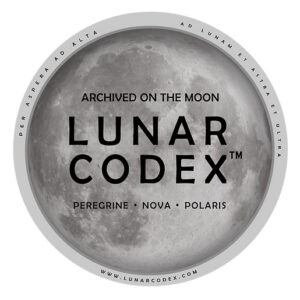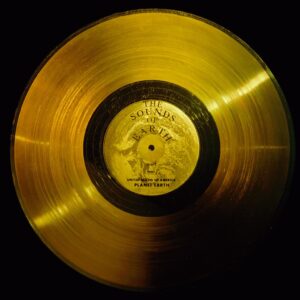 A time machine to the future, the ultimate anthology, a museum on the moon, a message in a bottle: all these phrases describe the Lunar Codex, a massive contemporary art collection going to the moon in digitalized, miniaturized form. Theses works exemplify a variety of fine art, poetry, magazines, music, film, podcasts, and books created by 30,000 artists of all stripes representing 157 countries. The project places an emphasis on countries formerly underrepresented in the art world OR countries likely to become greatly compromised by global warming.
A time machine to the future, the ultimate anthology, a museum on the moon, a message in a bottle: all these phrases describe the Lunar Codex, a massive contemporary art collection going to the moon in digitalized, miniaturized form. Theses works exemplify a variety of fine art, poetry, magazines, music, film, podcasts, and books created by 30,000 artists of all stripes representing 157 countries. The project places an emphasis on countries formerly underrepresented in the art world OR countries likely to become greatly compromised by global warming.
Samual Peralta Founded the Lunar Codex Project
Samual Peralta is a Canadian physicist, chairman of the technology company Incandence, Inc., art collector, poet, and son of two Filipino artists. The COVID pandemic forced Peralta into lockdown where he began the Lunar Codex as a fun experiment to get his poetry and sci-fi books on the moon. To do this he developed new archival technology, lightweight and highly compressed. Now he’s set his sights VERY high indeed. He created a virtually indestructible record of the Earth’s arts today for the moon. He chose the artists for the Codex himself. Artists also find him, and the condition for acceptance stipulates they have been shown or published.
 One Codex capsule already orbited the moon with NASA’s Orion Mission, launched November 16, 2022, and returned to Earth December 11 2022, via Artemis I. A space launch system in parallel with the Artemis Program will send scientific equipment to the moon for three years from 2023-2026, via commercial lunar payload services. NASA awards contracts to aerospace engineering companies who construct landing modules, and these commercial companies sell small spaces on the modules. For example, one company charges $3,270 for a one by one-half inch space on board. Companies such as SpaceX allow payloads to launch on commercial rocket platforms.
One Codex capsule already orbited the moon with NASA’s Orion Mission, launched November 16, 2022, and returned to Earth December 11 2022, via Artemis I. A space launch system in parallel with the Artemis Program will send scientific equipment to the moon for three years from 2023-2026, via commercial lunar payload services. NASA awards contracts to aerospace engineering companies who construct landing modules, and these commercial companies sell small spaces on the modules. For example, one company charges $3,270 for a one by one-half inch space on board. Companies such as SpaceX allow payloads to launch on commercial rocket platforms.
Peralta scheduled, and will pay for, three more capsules to go to the moon—to STAY. Coming soon to the moon is the Peregrine Collection, landing with Astrobotic’s Peregrine Mission close to the Oceanus Procellarum. The Nova Collection will land near the lunar South Pole. The Polaris Collection will land in the Nobile Crater.
Lunar Codex “Manifests”
 Follow “earthbound documentation” of the project detailing the NASA programs, rockets, and lunar landers at lunarcodex.com. The site serves as the manifest of all the contemporary artists in the time capsules. Peralta’s curated collection launched through the development of unique archival technology, but we’ve headed towards this moment for a while. Remember Carl Sagan and Voyager’s 1977 Gold Disk? The Codex archives uses special color capturing methods and “reconstruction” diagrams. So, any person, or dare we say alien, can view them once discovered.
Follow “earthbound documentation” of the project detailing the NASA programs, rockets, and lunar landers at lunarcodex.com. The site serves as the manifest of all the contemporary artists in the time capsules. Peralta’s curated collection launched through the development of unique archival technology, but we’ve headed towards this moment for a while. Remember Carl Sagan and Voyager’s 1977 Gold Disk? The Codex archives uses special color capturing methods and “reconstruction” diagrams. So, any person, or dare we say alien, can view them once discovered.
The New York Times reports that the moon has hosted earthly art for decades. You may recall the Moon Museum, a tiny ceramic tile attached to the leg of a lunar module abandoned by the Apollo 12 Mission in 1969. In 1971 NASA left a sculpture of an astronaut on the moon to commemorate the fourteen American and Soviet Astro and Cosmo naughts who lost their lives in moon missions.
 Nasa’s Artemis I, which carried the Codex capsule already orbiting the moon, also plans to land a woman on the moon. Appropriately, the Lunar Codex boasts the honor of the first ‘moon art’ collection to launch women artists’ work around or on the moon. The Codex also becomes the first lunar art project to include disabled artists’ work, contemporary films and music, and all varieties of mediums for making art: wood, clay, bronze, stone, mosaic, cloth, inked tattoo work, digital art, spray painted urban art, and poetry from authors both human and AI. Clearly a wonderful expression of human creativity will be stored for the future on the moon. If you get a email from Samuel Peralta saying, “I’d like to put you on the moon,” believe him!
Nasa’s Artemis I, which carried the Codex capsule already orbiting the moon, also plans to land a woman on the moon. Appropriately, the Lunar Codex boasts the honor of the first ‘moon art’ collection to launch women artists’ work around or on the moon. The Codex also becomes the first lunar art project to include disabled artists’ work, contemporary films and music, and all varieties of mediums for making art: wood, clay, bronze, stone, mosaic, cloth, inked tattoo work, digital art, spray painted urban art, and poetry from authors both human and AI. Clearly a wonderful expression of human creativity will be stored for the future on the moon. If you get a email from Samuel Peralta saying, “I’d like to put you on the moon,” believe him!